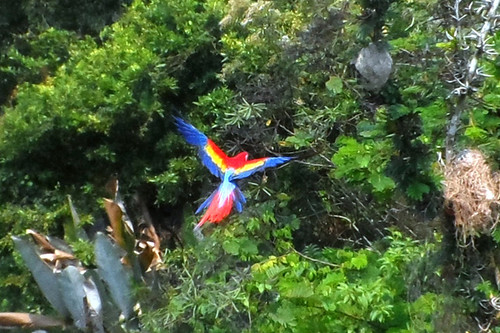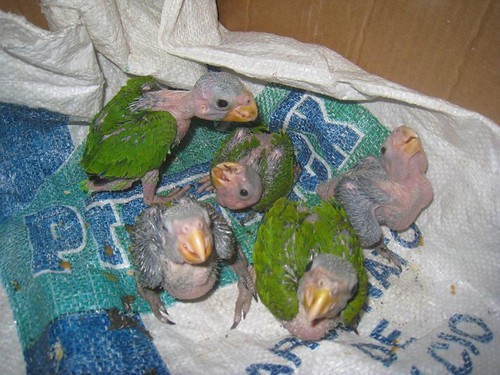Efforts to save Guatemala's iconic birds
 Sunday, August 4, 2013 at 2:56
Sunday, August 4, 2013 at 2:56 A conservation programme monitors and protects macaws' last remaining stronghold in El Peru.
 Ara macao - Scarlet Macaw | in
Ara macao - Scarlet Macaw | in  Conservation,
Conservation,  Poaching,
Poaching,  Wild bird trade
Wild bird trade
 Sunday, August 4, 2013 at 2:56
Sunday, August 4, 2013 at 2:56 A conservation programme monitors and protects macaws' last remaining stronghold in El Peru.
 Ara macao - Scarlet Macaw | in
Ara macao - Scarlet Macaw | in  Conservation,
Conservation,  Poaching,
Poaching,  Wild bird trade
Wild bird trade  Sunday, July 14, 2013 at 11:53
Sunday, July 14, 2013 at 11:53  A new education center at the Ara Project’s property in Punta Islita, in the northwestern province of Guanacaste, is located at an elevated viewpoint that allows visitors to see free-flying macaws. Image by Charlie FayersThe U.K. Embassy in San José donated funds to build a new education center and lodging for the Ara Project in Punta Islita.
A new education center at the Ara Project’s property in Punta Islita, in the northwestern province of Guanacaste, is located at an elevated viewpoint that allows visitors to see free-flying macaws. Image by Charlie FayersThe U.K. Embassy in San José donated funds to build a new education center and lodging for the Ara Project in Punta Islita.
 Ara macao - Scarlet Macaw | in
Ara macao - Scarlet Macaw | in  Conservation,
Conservation,  Funding
Funding  Monday, June 10, 2013 at 23:21
Monday, June 10, 2013 at 23:21  Scarlet macaw in flight. Photo by Raul Miranda. On April 21, 2013, the first flock of scarlet macaws (of many more to come) was released into the jungles of Aluxes Ecopark, nearby classified World Heritage Site Palenque National Park, as a part of a massive reintroduction project to restore the popular and culturally-significant bird to the well preserved rainforests of Palenque and the rest of its southern Mexico homeland—where the species has been extinct for close to 70 years. The highly anticipated release was the result of years of coordinated efforts between the conservation ecoparks Aluxes and Xcaret, the Institute of Biology of the University of Mexico (UNAM), and the Mexican environmental agency (SEMARNAT).
Scarlet macaw in flight. Photo by Raul Miranda. On April 21, 2013, the first flock of scarlet macaws (of many more to come) was released into the jungles of Aluxes Ecopark, nearby classified World Heritage Site Palenque National Park, as a part of a massive reintroduction project to restore the popular and culturally-significant bird to the well preserved rainforests of Palenque and the rest of its southern Mexico homeland—where the species has been extinct for close to 70 years. The highly anticipated release was the result of years of coordinated efforts between the conservation ecoparks Aluxes and Xcaret, the Institute of Biology of the University of Mexico (UNAM), and the Mexican environmental agency (SEMARNAT).
 Ara macao - Scarlet Macaw | in
Ara macao - Scarlet Macaw | in  Conservation,
Conservation,  Re-introduction,
Re-introduction,  Release
Release  Monday, May 27, 2013 at 23:39
Monday, May 27, 2013 at 23:39  Poached parrots nestlings at the rescue centre. Illegal trafficking of native parrots for house pets has been an escalating problem over the past several years. These birds are captured at a very young age to be sold as pets in the illegal pet trade market. The process results not only in the destruction of trees and life-long nests, but usually the death of the majority of the hatchlings that are taken for the pet trade.
Poached parrots nestlings at the rescue centre. Illegal trafficking of native parrots for house pets has been an escalating problem over the past several years. These birds are captured at a very young age to be sold as pets in the illegal pet trade market. The process results not only in the destruction of trees and life-long nests, but usually the death of the majority of the hatchlings that are taken for the pet trade.
 Thursday, May 9, 2013 at 1:16
Thursday, May 9, 2013 at 1:16  Ara macao - Scarlet Macaw | in
Ara macao - Scarlet Macaw | in  Research
Research